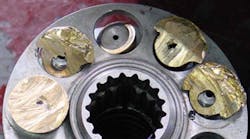A manufacturing company recently hired me to check the performance of four hydraulic pumps operating a large hydraulic press. The hydraulic pumps had clocked over 10,000 hours in service and the customer's concern was that if pump performance was down, production would be too.
My test results revealed that the performance of all four pumps was within acceptable limits. So in my report, I advised my client that there would only be a minimal increase in productivity if the pumps were replaced. I further advised that the change-out of all four pumps should be scheduled urgently!
The foundation for this recommendation was that the pumps had exceeded their expected service life and in the absence of an effective condition-based maintenance program, the probability of an in-service bearing failure was significantly increased.
When a hydraulic component fails in service, large amounts of metallic particles are generated. These particles circulate in the hydraulic fluid, often causing damage to other components before the system's filters can remove them. In extreme cases, the contamination load can clog the hydraulic filters, which results in unfiltered fluid being circulated through the system.
A component that fails in service is almost always more expensive to rebuild than a component that is removed from service in a pre-failed condition. This is because a failure in service usually results in mechanical damage to the internal parts of the component. As a consequence, parts that would have been serviceable have to be replaced. In extreme cases, components that would have been economical to repair become uneconomical to repair, increasing the cost of component replacement by up to 40%.
This client took my advice, but unfortunately, a bearing failed in one of the pumps before all of the change-outs were completed. A piece of cage from the failed bearing found its way into the main hydraulic cylinder, causing $6,000 damage. And the pump that failed cost 50% more to rebuild than the three units that were removed from service in pre-failed condition. Suffice to say, the additional repair costs in this case were significant and could have been avoided, if the pumps had been changed-out once they achieved their expected service life.
To minimize the chances of hydraulic components failing in service, the machine manufacturers' recommendations on expected service life should be used to schedule component change-outs. It may be possible to safely extend service life beyond that recommended through careful application of condition-based monitoring techniques, such as oil analysis (wear debris analysis). But unless an effective, predictive maintenance program is in place, running hydraulic components beyond their expected service life is usually a costly mistake. And to discover six other costly mistakes you want to be sure to avoid with your hydraulic equipment, get "Six Costly Mistakes Most Hydraulics Users Make... And How You Can Avoid Them!" available for FREE download here.

Continue Reading
Continue Reading
BOOK 2, CHAPTER 12: Fluid Motor Circuits
March 18, 2009
Motor leakage variations
Oct. 18, 2006
Sponsored Recommendations
Sponsored Recommendations
How Variable Volume Pumps Work
Feb. 6, 2024
What is a Check Valve and How Does it Work?
Feb. 6, 2024
